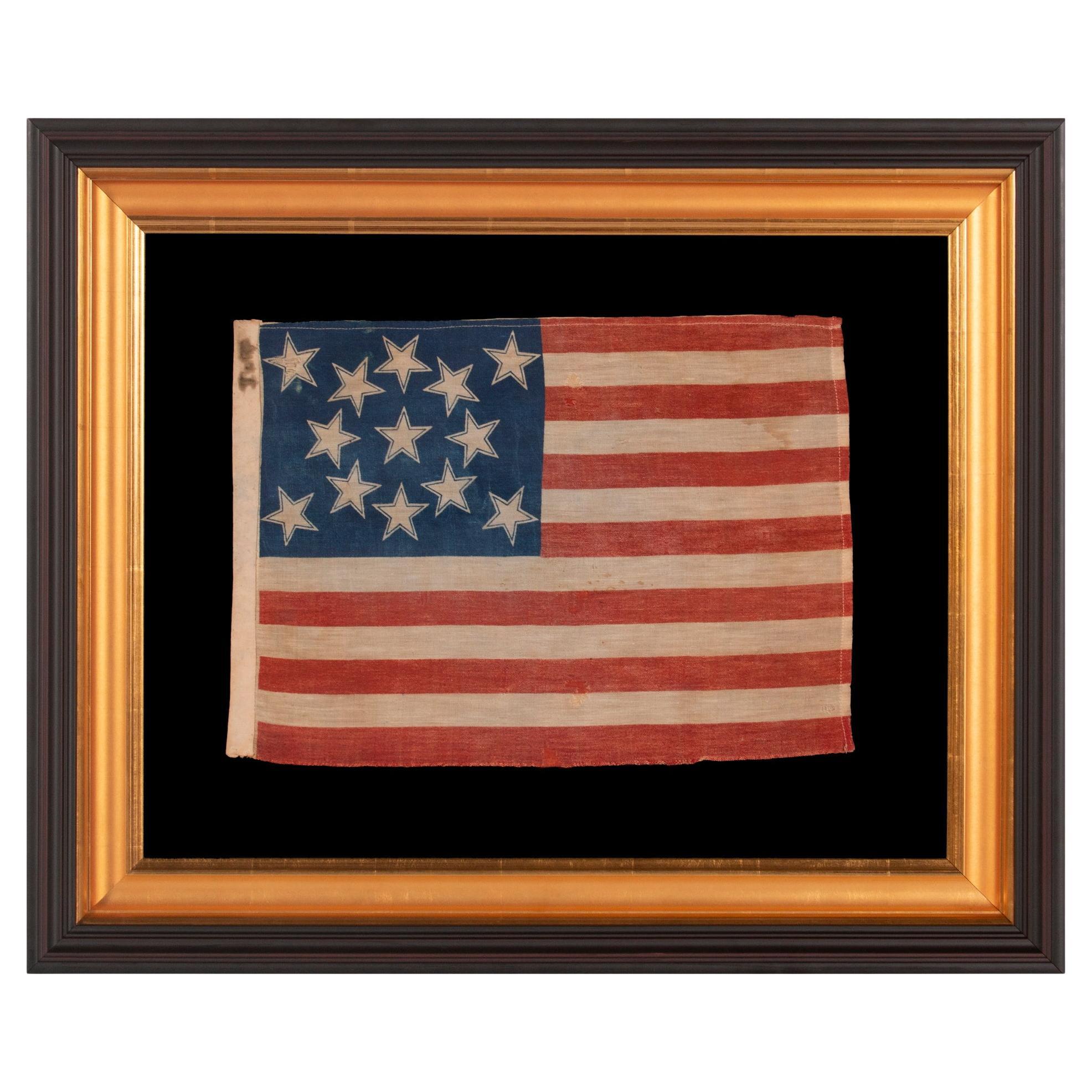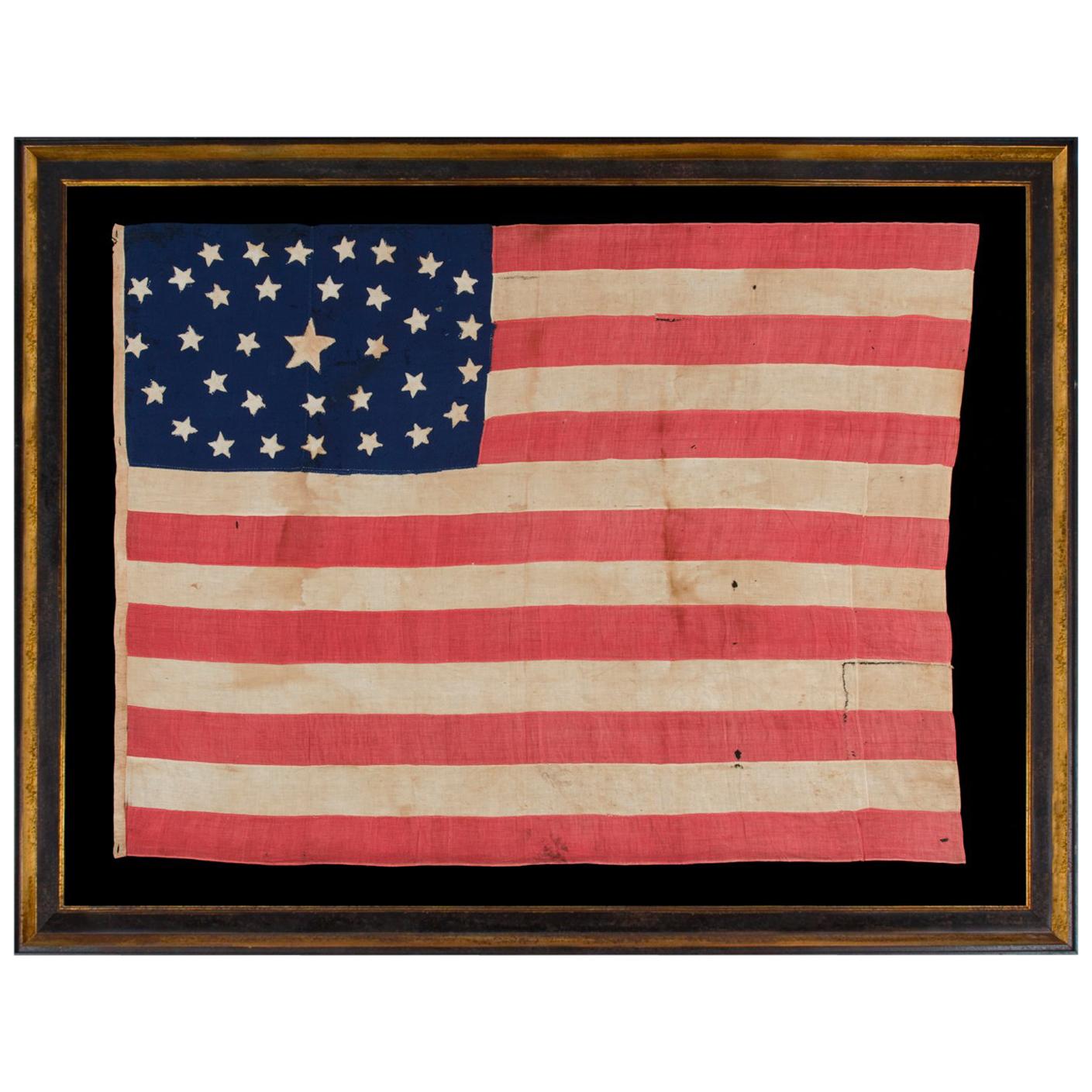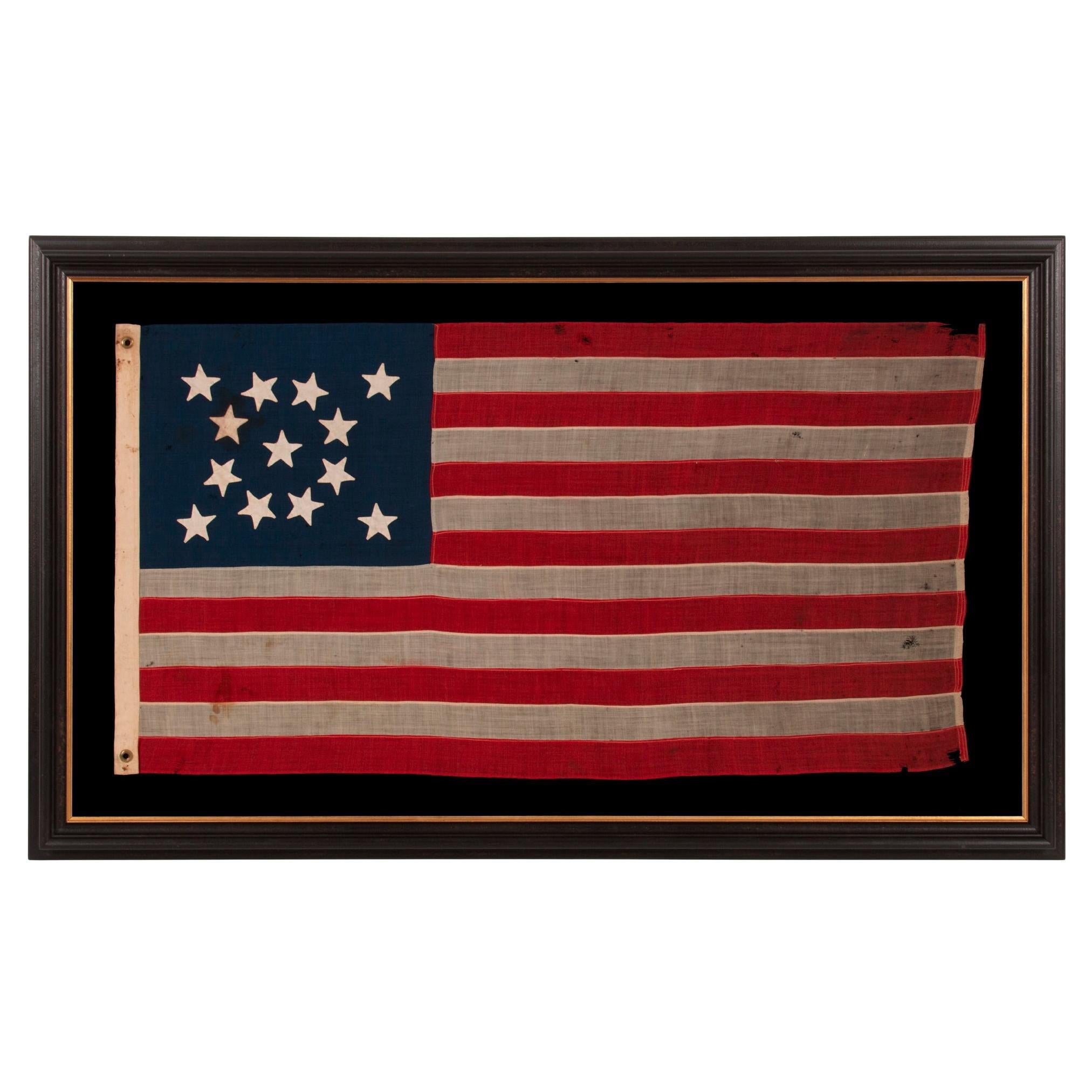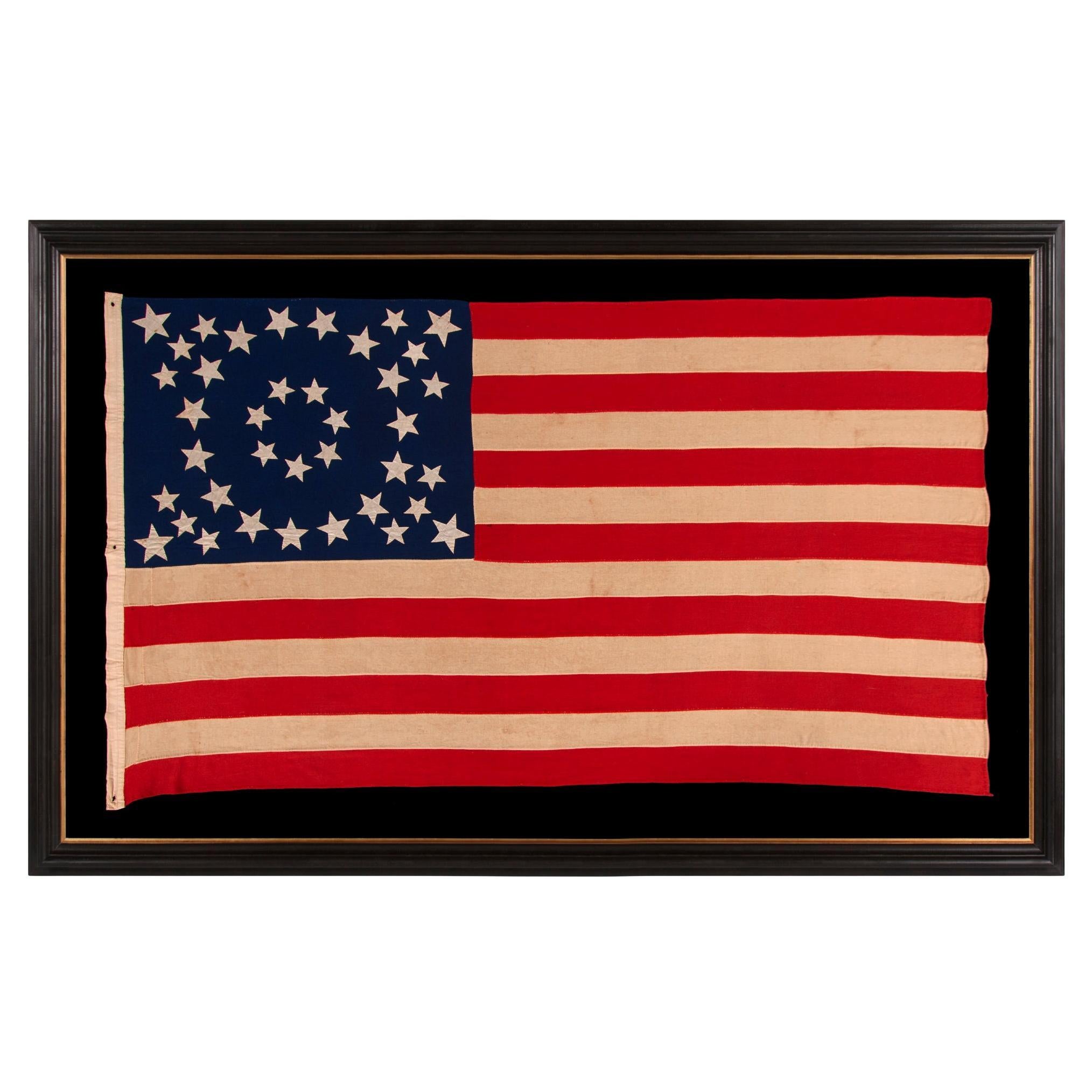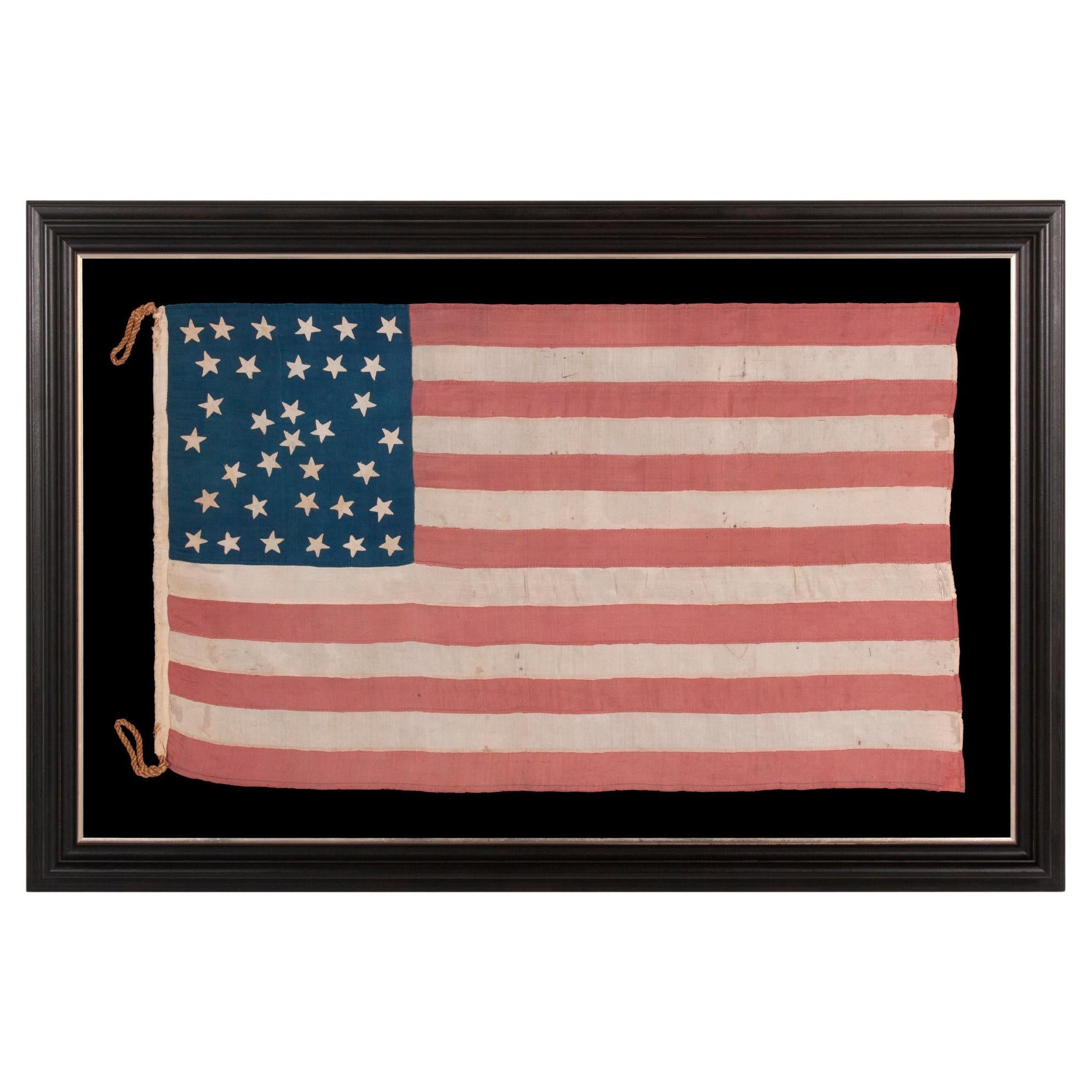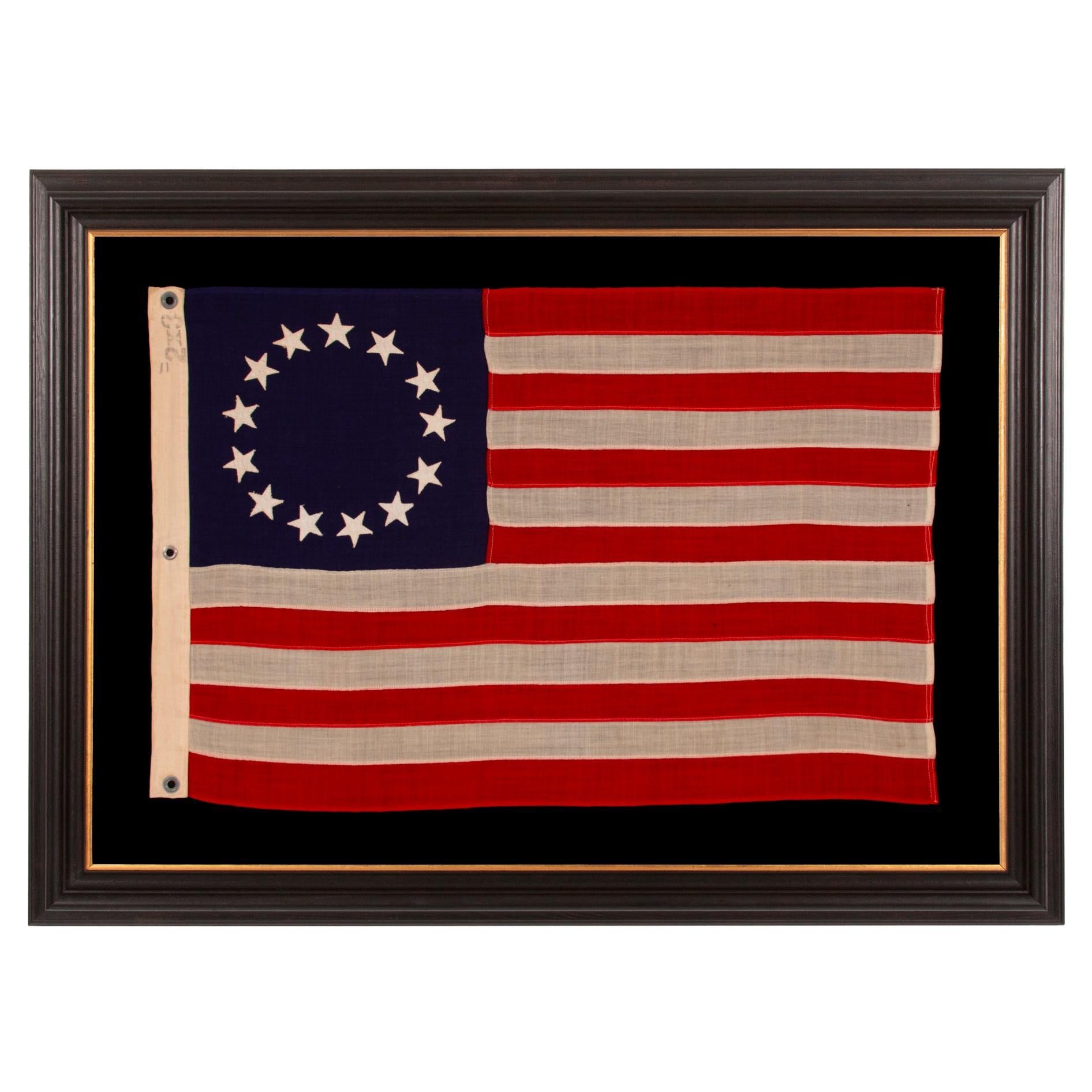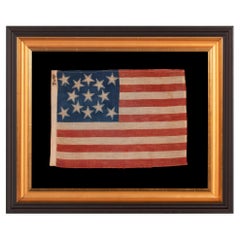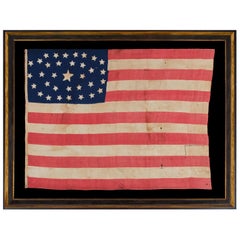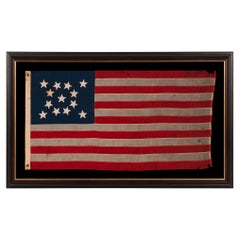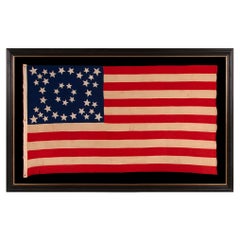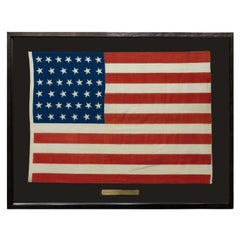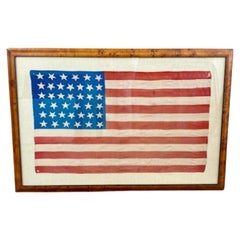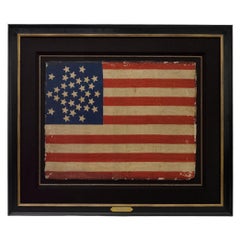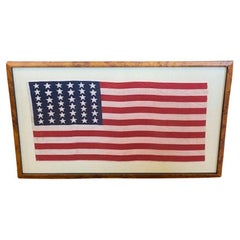Items Similar to 42 Stars in a Whimsical Medallion Configuration, ca 1889-1890
Want more images or videos?
Request additional images or videos from the seller
1 of 5
42 Stars in a Whimsical Medallion Configuration, ca 1889-1890
Price Upon Request
Price Upon Request
Price Upon Request
Price Upon Request
Price Upon Request
Price Upon Request
Price Upon Request
Price Upon Request
Price Upon Request
Price Upon Request
Shipping
Retrieving quote...The 1stDibs Promise:
Authenticity Guarantee,
Money-Back Guarantee,
24-Hour Cancellation
About the Item
42 STARS IN A WHIMSICAL MEDALLION CONFIGURATION THAT FEATURES A LARGE, HALOED CENTER STAR AND INCORPORATES 7 TINY STARS; NEVER AN OFFICIAL STAR COUNT, EXCEPTIONALLY RARE, REFLECTS THE ADDITION OF WASHINGTON STATE, circa 1889-1890
42 star American parade flag, printed on cotton, with an exceptionally unusual form of double-wreath style medallion configuration that features a large center star, with a pinstriped halo, and 7 small stars interspersed. 5 of these are placed between the arms of center star, with the remaining two set wide apart, flanking the circular formation to the left and right.
Although the maker that produced these flags is unknown, others with a haloed center star exist in at least five different star counts including 30, 31, 34, 35, and 36. Three examples also exist, perhaps from different makers, that bear 13 stars. One of these dates to 1856, made for the presidential campaign of James Buchanan. Another was made for the 1860 presidential campaign of John Bell, who ran against Abraham Lincoln, as an independent, on the Constitutional Union Party ticket. Another style, printed on a wool and cotton blended fabric, dates to the 1876 centennial and all of its 13 stars have halos.
This type of 42 star flag was made by hand-carving stars in relief into a block of wood, which was then dipped into red or blue pigment, and applied to white cotton fabric. The star counts of parade flags, printed in this manner, could be updated by carving additional stars into the old block, so that when pressed against the cloth, more would appear in the resulting pattern.
Having owned all of the types of flags listed above, with the exception of the Buchanan variant, I am very familiar with them and the sizes in which they were made. In at least three instances, I have identified flags from the first maker, that were printed with blocks subsequently updated to the 42 star count.
The particular flag that is the subject of this narrative, was created from an identifiable, 35 star print block, used in the late Civil War period (1863-65) to create a type of flag that I am intimately familiar with. 7 smaller stars were added to this design to achieve the count of 42. Interestingly enough, the earlier, 35 star example, while scarce, is far-and-away more common than its 42-star counterpart, in spite of the flag that it was made approximately a quarter century prior.
It is of interest to note that the other two known variants with 42 stars and a haloed center star, both smaller than the flag in question here, were updated from identified print blocks used to create 30 and 34 star flags (dating to 1848-1850, and 1861-1863, respectively). All of the 42 star halos, as I call them, are so rare that I have not encountered more than ten examples in total across all three varieties. Presently I know of six in the largest variety, one in the next size smaller, and three in the smallest. I have had the great privilege to own 8 of the 10. One of the remainder is among the holdings of the State of Wyoming. The last I mounted and framed for a dear friend and client.
Well beyond the rarity and the interesting trail of updated print blocks, what really makes this flag terrific is its presentation. The whimsical star pattern is balanced, bold, and dynamic—as good as about anything I can think of in 19th century examples of the Star & Stripes. The soldier blue color of the canton is certainly attractive, but the saturated, sunburnt red is extraordinarily beautiful.
Unlike most antique textiles that are avidly collected, flags were generally used outdoors and there is something about a degree of wear that makes them more appealing. In some cases, if visually interesting, even a ton of wear can be great from a visual perspective, actually increasing desirability as opposed to decreasing it. Note how the losses in this example tell a story of its obvious use, translating its age in an endearing and attractive fashion.
The 42 star flag is interesting from a historical perspective, both because 42 was never an official count, and because 42 star flags were only produced for about 8 months, from November, 1889 – July 4th, 1890. After 1818, star counts became official on the 4th of July each year. A new star was therefore officially added on Independence Day for every state that had been added over the preceding “flag year”. Flag makers, however, did not wait for July 4th and official star counts. Flag production was a competitive industry and no one wanted to be making 38 star flags, for example, when their competitors were making 42’s and there were 42 states.
In 1876, the year of our nation’s centennial of independence, some flag-makers were producing 37 star flags to reflect what would actually remain the official number until July 4th, 1877. Many were making 38 star flags to include Colorado, that joined the Union to become the “Centennial State” on August 1st, 1876. Still others were making flags with 39 stars, in anticipation of the addition of not only Colorado, but the Dakota Territory, then thought to be coming as one state.
13 years would then pass without the addition of more states—the longest such period in the 19th century. At the same time, America was growing and production was getting more advanced. Private citizens were displaying the American flag more than they ever had in history. By 1889, some flag-makers were once again producing 39 star flags, in anticipation of the Dakota Territory, which entered on November 2nd as two separate states, a fact that rendered all 39 star examples both unofficial and inaccurate for so much as a day. The Dakotas were closely followed by Montana, on the 8th of that month, and Washington State on the 11th. With 4 new states in less than a week-and-a-half, most flag makers added 4 stars, accordingly, to the count of 38 still official at the time.
Less than 8 months later, on July 3rd, 1890, Idaho joined the Union as the 43rd state, taking the count of states to 43 just one day before the 42 star flag would have become official. Interestingly enough, almost all flag-makers skipped the 43 star count entirely, once again in spite of its official status, because Wyoming gained statehood on July 10th. The preceding series of events makes 42 star flags both an interesting part of our nation’s heritage and a classic display of American capitalism.
Mounting: The flag was mounted and framed within our own conservation department, which is led by expert staff. We take great care in the mounting and preservation of flags and have framed thousands of examples.
The flag has been hand-stitched to 100% cotton, black in color, that was washed and treated for colorfastness. The black-painted molding, with its wide, sculpted profile and gilded inner lip, is Italian. The glazing is U.V. protective acrylic (Plexiglas).
Condition: There is modest fabric breakdown with associated loss along the bottom of the hoist end, and modest to moderate of the same, with a scattering of tiny holes, in and around the fly end of the 1st white stripe. There are vertical tears in the three white stripes below the canton, near the hoist end. Period cotton fabric of similar coloration was placed behind these areas for masking purposes. There is minor foxing and water staining throughout, accompanied by modest of the same along the fly end. There is very minor fading. Many of my clients prefer early flags to show their age and history of use. The extreme rarity of this example, accompanied by its wonderful presentation, all but nullifies any condition issues.
- Dimensions:Height: 30.75 in (78.11 cm)Width: 40 in (101.6 cm)Depth: 2.5 in (6.35 cm)
- Materials and Techniques:
- Place of Origin:
- Period:
- Date of Manufacture:1889-1890
- Condition:See Item Description.
- Seller Location:York County, PA
- Reference Number:Seller: 42j-9381stDibs: LU849742071212
About the Seller
5.0
Recognized Seller
These prestigious sellers are industry leaders and represent the highest echelon for item quality and design.
Established in 1991
1stDibs seller since 2008
70 sales on 1stDibs
Typical response time: Several days
- ShippingRetrieving quote...Shipping from: York County, PA
- Return Policy
Authenticity Guarantee
In the unlikely event there’s an issue with an item’s authenticity, contact us within 1 year for a full refund. DetailsMoney-Back Guarantee
If your item is not as described, is damaged in transit, or does not arrive, contact us within 7 days for a full refund. Details24-Hour Cancellation
You have a 24-hour grace period in which to reconsider your purchase, with no questions asked.Vetted Professional Sellers
Our world-class sellers must adhere to strict standards for service and quality, maintaining the integrity of our listings.Price-Match Guarantee
If you find that a seller listed the same item for a lower price elsewhere, we’ll match it.Trusted Global Delivery
Our best-in-class carrier network provides specialized shipping options worldwide, including custom delivery.More From This Seller
View All13 Haloed Stars in A Medallion Configuration, ca 1876
Located in York County, PA
13 HALOED STARS IN A MEDALLION CONFIGURATION, ON AN EXCEPTIONALLY RARE ANTIQUE AMERICAN FLAG MADE FOR THE 1876 CENTENNIAL OF AMERICAN INDEPENDENCE
13 star American parade flag, prin...
Category
Antique 1870s American Political and Patriotic Memorabilia
Materials
Cotton
Price Upon Request
34 Stars in an Outstanding Oval Medallion Configuration, Civil War Period
Located in York County, PA
34 STARS IN AN OUTSTANDING OVAL MEDALLION CONFIGURATION, ON A NARROW CANTON THAT RESTS ON THE 6TH STRIPE, ON A HOMEMADE, ANTIQUE AMERICAN FLAG OF THE CIVIL WAR PERIOD, ENTIRELY HAND-...
Category
Antique 1860s American Political and Patriotic Memorabilia
Materials
Cotton
13 Star Antique American Flag , Hand-Sewn Stars in a Medallion, 1876 Centennial
Located in York County, PA
13 STAR ANTIQUE AMERICAN FLAG WITH A MEDALLION CONFIGURATION OF HAND-SEWN STARS AND A BEAUTIFUL, ELONGATED PROFILE, MADE IN THE ERA OF THE 1876 CENTENNIAL OF AMERICAN INDEPENDENCE, I...
Category
Antique 1870s Political and Patriotic Memorabilia
Materials
Wool
Exceptional American Flag, 38 Stars in 3 Sizes in a Fantastic, Unusual Medallion
Located in York County, PA
EXCEPTIONAL ANTIQUE AMERICAN FLAG WITH 38 GLAZED COTTON STARS, IN 3 DIFFERENT SIZES, ARRANGED IN A BEAUTIFULLY GRAPHIC, DOUBLE-WREATH STYLE MEDALLION, WITH TRIANGLES OF 4 STARS IN ...
Category
Antique Late 19th Century North American Political and Patriotic Memorab...
Materials
Wool
34 Star Antique American Flag with Hourglass Medallion Stars, ca 1861-1863
Located in York County, PA
EXTRAORDINARY 34 STAR ANTIQUE AMERICAN FLAG WITH AN ACCORDION OR HOURGLASS MEDALLION CONFIGURATION THAT SURROUNDS A PENTAGON OF STARS IN THE CENTER; MADE OF FINE SILK AND ENTIRELY HAND-SEWN; MADE DURING THE OPENING YEARS OF THE CIVIL WAR (1861-63), IN A TINY SIZE AMONG ITS COUNTERPARTS OF THE PERIOD; REFLECTS THE ADDITION OF KANSAS AS THE 34TH STATE
34 star flag of the Civil War period with an array of rare, beautiful, and otherwise desirable features. Extremely small among flags of this period with pieced and sewn construction, the flag displays a star pattern that is not only highly unusual, but unique to this particular example. This consists of a single star in the very center, surrounded by a pentagon of stars, flanked by angular bracket of three stars to either side. Above and below are rows of 5 stars, followed by rows of 6 that line the top and bottom of the canton. The resulting configuration is what I have termed an “accordion medallion,” though “hourglass medallion” or “standing bow tie” would be perfectly acceptable.
When rotated 90 degrees, to view the harder-to-identify, bow tie formation, students of early star patterns may note the visual similarity between this and what I call “Starburst” or “Crosshatch” medallions. The pattern, however, conspicuously lacks the crosses of St. Andrew (a saltire) and St. George (roman cross), that would allow it to be more accurately categorized as such.
Entirely hand-sewn, the canton and stripes of the flag are made of fine silk. The hemming of this was accomplished with great skill. The top and bottom edges are selvedge. These are so similar in nature as to have come from the same maker. There is a white, silk binding along the hoist, in the form of an open sleeve, through which a length of braided hemp rope was passed, expertly looped and re-braided into itself at the top and bottom for strength.
The stars are made of white, polished cotton. These were stitched to both sides (double-appliqued). Note how the edges of the fabric were not turned under, providing evidence of the fact that the maker was not especially skilled in appliqueing. This was common, as applique work was far more difficult than producing French seams.
In the 19th century, most flags with pieced and sewn construction were 8 feet long and larger. A six-footer was considered small. Even military battle flags, carried on foot, measured 6’ x 6.5’, which translates into approximately 7’ x 7.5’ after framing, about the size of an average quilt and larger than can comfortably fit on a wall in a house with 8-foot ceilings and average width baseboard. Flags smaller than this were produced both commercially and at home, but the smaller they are, the more unusual they are. At just 26.5 x 46.5 inches, this flag is extremely small for a Civil war period flag with sewn construction.
Silk was both beautiful and lightweight, which made it elegant for military unit colors and preferable for flags meant to be carried on foot. Most outdoor use flags...
Category
Antique 1860s American Political and Patriotic Memorabilia
Materials
Silk
13 Stars in a Betsy Ross Pattern, ca 1910-1926
Located in York County, PA
13 STARS IN THE BETSY ROSS PATTERN ON A SMALL-SCALE ANTIQUE AMERICAN FLAG MADE SOMETIME BETWEEN APPROXIMATELY 1910 AND THE 1926 SESQUICENTENNIAL OF AMERICAN INDEPENDENCE
13 star fla...
Category
Mid-20th Century Political and Patriotic Memorabilia
Materials
Wool
Price Upon Request
You May Also Like
39-Star Antique American Flag with 'Whimsical' Star Pattern, 1889
Located in Colorado Springs, CO
This is a 39-star unofficial American flag, handmade and printed on cotton. The flag dates to 1889 and has a unique history, thanks to its rare star-count.
The flag’s canton is prin...
Category
Antique 1880s American Political and Patriotic Memorabilia
Materials
Cotton
19th Century American 39 Star Flag, circa 1889
Located in Nantucket, MA
19th Century American 39 Star Flag, circa 1889, a period printed silk parade flag with a wavy pattern of dancing stars. This was never an official flag of the United States but was m...
Category
Antique 1880s American Federal Political and Patriotic Memorabilia
Materials
Silk
31-Star Printed American Flag, Celebrating California Statehood, Circa 1850
Located in Colorado Springs, CO
This is a rare 31-star medallion printed American flag, celebrating the addition of California to the Union. The flag is printed on silk and has a spectacular “Great Star” canton pat...
Category
Antique 1850s American Political and Patriotic Memorabilia
Materials
Silk
19th Century 39 Star American Flag, circa 1889
Located in Nantucket, MA
19th Century 39 Star American Flag, circa 1889, a printed linen ensign with 39 stars arranged in a wavy star pattern, with stripes in a very unus...
Category
Antique 1880s American Federal Political and Patriotic Memorabilia
Materials
Linen
39-Star Printed American Flag, Commemorating North Dakota Statehood, 1889-1890
Located in Colorado Springs, CO
This is a 39-star unofficial American flag, celebrating North Dakota statehood. The printed flag dates to 1889 and showcases a “whimsical” star pattern in the canton. The flag's cant...
Category
Antique 1880s American Political and Patriotic Memorabilia
Materials
Fabric
48-Star Printed American Flag, Commemorating Arizona Statehood, 1912-1958
Located in Colorado Springs, CO
This is an original 48-star American parade flag, celebrating Arizona statehood. A wonderful product of our nation's early history, this flag is an authentic antique, with a fly date...
Category
Mid-20th Century American Political and Patriotic Memorabilia
Materials
Fabric
More Ways To Browse
Black Memorabilia
4th Of July
Profile Medallion
Antique Black Wood Stain
19th Century American Flag
Centennial 1876
Small American Flag
Antique American Flag Framed
Gilded Age Antiques
Old Canton
Star Wars Prints
U S Furniture Industries
Fabric Circa 1850
Folk Art Soldier
Wool Flag
Antique Union Cases
Fox Mask
Whimsical Wood Carving
